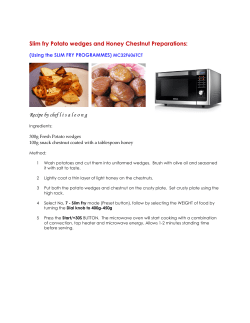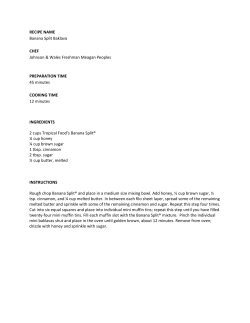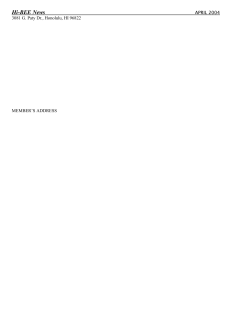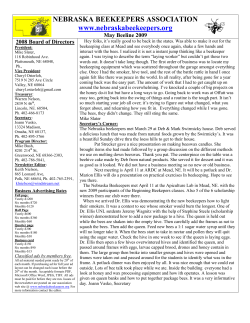
External Applications of Honey
Book of Honey, Chapter 8 External Applications of Honey Stefan Bogdanov Bee Product Science, www.bee-hexagon.net Wound healing was probably the first use of honey for human health. According to the Ebers papyrus (1550 BC) honey is included in 147 prescriptions in external applications. Also according to the Smith papyrus (1700 BC) it was used in wound healing: “Thou shouldst bind [the wound] with fresh meat the first day [and] treat afterwards with grease, honey [and] lint every day until he recovers.” Pabasa tombs, 26 e Dynasty, 760-656 BC HONEY FOR WOUND HEALING UNDER HOME CONDITIONS Besides scientifically based use of honey in wound care in hospitals (see next section), honey can also be used under home conditions, as it was used for many centuries. Although sterilised honey is only used in hospitals, raw honey can also be used under home conditions without any risk, as no adverse effects have been reported. Indeed, Prof. Descotte lectured in several Apitherapy conferences that his team has used raw honey routinely for wound care in hundreds of cases in the hospital of Limoge, France. Application of honey for wound healing under home conditions, after 5 It is not necessary to disinfect wound because honey will disinfect it 1. Apply honey as much honey on a gauze or clean cotton cloth as it is necessary to cover wound fully. Gauze and cloth need not be sterile. 2. Abscesses, cavity or deep wounds need more honey to adequately penetrate deep into the wound tissues. The wound bed should be filled with honey before applying the honey dressing pad. 3. Change bandage once a day. When doing it, wound need not be cleaned from honey. Honey is „dissolved“ in the wound or sticks to the gauze. 4. When changing the bandage remove hornification at the border of the wound with a pincette. This can be done under running water or with a soft tooth brush. Cell debris, which were not removed will not disturb healing process. 5. After cleaning, wound should be padded with as much gauze as is needed for drawing the wound liquid. 6. If wound is infected by yeast or it heals badly, a mixture of honey-betadine 1:1 can be used. Bee Product Science, August 2009 1 Book of Honey, Chapter 8 Honey applied in wound healing in a Swiss hospital, photos and comment courtesy Kathrin Rieder. The treatment was carried out was carried out as described above Wound at the treatment beginning A painful and infected wound on the left leg. The fracture was stabilised with plates and screws. After several operations the blood circulation of the leg was diminished and sores were built because of the prolonged bed lying. The wound treatment with conventional means was not successful. The patient agreed to make a honey treatment. After only 5 days of treatment the wound condition was signifantly improved. New tissues were built and the bacterial inflammation has diminished significantly After two months the wound was completely closed. The cicatrice is almost invisible and he skin is healthy, tender and elastic at the same time. HONEY AND WOUND CARE: AN OVERVIEW By Keith Cutting Reprint with permission from Ostomy Wound Management 9. History Until the first part of the 20th century, honey dressings were part of everyday wound care practice. With the advent of antibiotics in the 1930s and 1940s, views changed and honey was consigned to items of historical interest. Misuse of antibiotics, the emergence of resistant bacteria, and increasing interest in therapeutic honey have provided an opportunity for honey to be re-established as a broad-spectrum, antibacterial agent that is non-toxic to human tissue. Despite lack of promotional support from large corporations, interest in the use of honey in wound management has increased in recent years. However, a clinical profile in wound care commensurate with other modalities has not been achieved despite offering similar indications of use and an increase in research activity and clinical reports. Zumal and Lulat 37 observed, “The therapeutic potential of uncontaminated, pure honey is grossly underutilized.” Bee Product Science, August 2009 2 Book of Honey, Chapter 8 Clinicians need reassurance that any health-related agent is safe and meets its stated therapeutic purpose. Therefore, it is important to emphasize that although natural in origin, the honey used in wound care should be of medical-grade standard and not sourced from honey destined for the supermarket shelf. Medical grade honey is filtered, gamma-irradiated, and produced under carefully controlled standards of hygiene to ensure that a standardized honey is produced 35. Therapeutic benefit of honey in wound care The therapeutic properties of honey are variable and depend on the type of honey used 17. Manuka (the Maori name for the New Zealand tea tree/bush Leptospermum scoparium) or Leptospermum is honey derived from the tea tree; the former is the more widely used term. In a review of the literature, Moore showed that Manuka honey has “very special healing properties” and described it as “the best natural antibiotic in the world.”23. Medical grade Manuka honey is prepared purely for medical use and controlled by a rigorous set of systems and standards. These exacting standards apply to the leptospermum honey distributed in US (Medihoney™, Derma Sciences, Princeton, NJ). This product is a blend of L. scoparium (Manuka) and L. polygalifolium know as Jelly Bush. A systematic review 23 of honey as a wound dressing noting the dearth of good evidence on topical wound agents contradicts Molan’s literature review 19 of the evidence (17 randomized, controlled trials involving 1,965 participants and five clinical trials involving 97 participants, plus numerous case studies) — supports the use of honey as a wound dressing and underscores clinician failure to recognize that evidence. Molan’s10 research reviews also addressed the range of honey’s therapeutic activities 20 : Bioactivity of honey Suggested Rationale Prevention of cross-contamination Viscosity of honey provides a protective barrier Provides a moist wound healing environment Osmolarity draws fluid from underlying tissues Dressings do not adhere to wound surface. Tissue does not grow into dressings The viscous nature of honey provides an interface between wound bed and dressing Promotes drainage from wound Osmotic outflow sluices the wound bed Removes malodor Bacterial preference for sugar instead of protein (amino acids) means lactic acid is produced in place of malodorous compounds Promotes autolytic debridement Bacterial preference for sugar instead of protein (amino acids) means lactic acid is produced in place of malodorous compounds Stimulates healing Bio-active effect of honey Anti-inflammatory Number of inflammatory cells reduced in honey-treated wounds Managing infection Antiseptic properties found to be effective against a range of microbes including multi-resistant strains Wound bed preparation Wound bed preparation may be viewed as management of the wound in order to accelerate endogenous healing 20. The bio-activity of honey aligns closely with the concept of wound bed preparation. The physiology of healing in acute wounds is a carefully controlled series of events that ensures healing progresses in a timely fashion. However, in chronic wounds this orderly sequence is disrupted and the repair process is delayed. If wound bed preparation is to be successful, the impediments to healing must be recognized and addressed, implying appropriate management of exudate, devitalized tissue, and associated bioburden. The appropriate application of honey dressings offers a way forward in managing potential wound-related barriers to healing. Exudate A clinical study by Al-Waili and Saloom 2 compared honey with topical antiseptics in 50 patients with postoperative abdominal wound infections; Ahmed et al's 1 non-randomizes study of 60 patients with chronic surgical or trauma wounds; and Betts and Molan’s 4 in vivo pilot study reported that honey helps reduce the amount of wound exudate. This is most likely a consequence of honey’s anti-inflammatory properties Bee Product Science, August 2009 3 Book of Honey, Chapter 8 Inflammation — increased vessel permeability increases fluid movement into soft tissue, subsequently increasing surface exudate. A decrease in inflammatory cells has been found (histologically) in animal models following application of honey in full-thickness burns. Similar findings 28 have been reported in animal studies comparing ampicillin and nitrofuazone in treating infection of full-thickness wounds 16, 26. The anti-inflammatory activity of honey also has been documented in clinical studies of human burn wounds and in “in vitro studies 30, 31, 32 . The potential consequences of effectively managing inflammation include rapid reduction of pain, edema, and exudate; additionally, hypertrophic scarring is minimized by avoiding protracted inflammation that may result in fibrosis 22. It follows that reducing inflammation lessens exudate production and dressing change frequency, which may conserve resources in terms of dressings used, staff time, and unnecessary disturbance of the patient and the wound bed. Devitalized tissue It has been established that dressings that create the type of moist wound environment that honey provides facilitate the process of autolytic debridement. The osmotic pull of honey draws lymph from the deeper tissues and constantly bathes the wound bed. Lymph fluid contains proteases that contribute to the debriding activity of honey. In addition, the constant sluicing of the wound bed is believed to help remove foreign body (e g, dirt and grit) contamination 22. Molan 18 has suggested the most likely explanation for honey’s debriding activity involves the conversion of inactive plasminogen to plasmin, an enzyme that breaks down the fibrin that tethers slough and eschar to the wound bed. Stephen-Haynes 29who presented the results of three patient case studies and an additional five patients who benefited from management of wound malodor, attests to the clinical impact of honey in debridement. Malodor is known to occur in a variety of wounds in conjunction with slough and necrotic tissue; it is a particular concern when managing fungating lesions. Malodorous substances such as ammonia and sulphur compounds are produced when bacteria metabolize protein. Because honey provides bacteria an alternative source of energy (glucose), these noxious compounds are no longer produced and wound malodor is avoided. Maceration Macerated periwound skin can be a problem in some wounds and is often related to the dressing used 8. The osmotic action of honey, previously mentioned, has been shown in previous reviews of the literature to reduce the risk of maceration — honey draws moisture rather than donates it 22. Thus, periwound skin is protected from overhydration. Bioburden Honey has been shown in clinical observations to have the ability to manage wound infection in situations where conventional antimicrobial (antibiotics/antiseptics) have failed 10, 11, 36. Honey also has been found to be effective in vitro against a range of multiresistant organisms including methicillin-resistant Staphylococcus aureus (MRSA), vancomycin-resistant Enterococci (VRE), and other multiresistant Gramnegative organisms including Pseudomonas aeruginosa 12. Other in vitro studies involving different microorganisms also have demonstrated honey’s effectiveness against antibiotic-resistant bacteria 7, 15. George and Cutting specifically identified honey’s antibacterial activity 12. The binding of water can be added to these antibacterial properties: • The high sugar content/low water activity provides osmotic action • Acidic pH (3.2 to 4.5) inhibits bacterial growth • Glucose oxidase enzyme helps produce hydrogen peroxide • Plant-derived factors (present in some honeys and not specifically identified). The antibacterial action most likely reaches below the wound surface. Although topical honey manages superficial bacteria (bactericidal in action rather than bacteriostatic) 7, 34 it also has been shown in vitro to provide prompt clearance of deep-seated infection and boils with unbroken skin, suggesting that honey’s antibacterial activity may diffuse through the skin to deeper tissues. Cooper et al 7 performed sensitivity testing of 17 strains of P. aeruginosa isolated from infected burns using two honeys with different types of antibacterial activity; Wahdan 34 compared the antibacterial activity of a sugar solution and honey on 21 types of bacteria and two types of fungi. Bee Product Science, August 2009 4 Book of Honey, Chapter 8 Some commercial honey preparations used in wound healing Medihoney for wound care Medihoney wound gauze Antibacterial wound gel Moistering cream agains eczemas Wound-healing creams Wound dressing with Medihoney gauze Biofilms In recent years, attention has turned to the potential role of biofilms in wound infection. A biofilm may be described as a bacterial community living within a self- produced extracellular polysaccharide (EPS) matrix. The EPS protects the bacterial community from antimicrobial and phagocytic onslaught. Lately, in vitro evidence has indicated that honey is an effective agent for preventing biofilm formation. In an in vitro study it was found that laboratory-grown Pseudomonal biofilms were disrupted following application of Manuka honey 14, 25. These findings are particularly encouraging when considering the emergence of antimicrobialresistant bacteria. No evidence has yet been presented that bacterial resistance to honey has occurred — it is highly unlikely that bacteria will select for resistance to honey because bacteria rely on sugar as a source of food. Cross-contamination Use of honey dressings may help prevent cross contamination. This is and will remain an important issue in healthcare. The viscous nature of honey is believed to provide a physical barrier that helps safeguard patients by preventing cross contamination. Dressing wounds with honey All dressings must be used in accordance with the manufacturer’s instructions. This helps endorse the maxim do no harm and ensure that the full benefit of the product is realized. Because of its fluid and viscous nature, honey can be difficult to apply. This is particularly true when profuse exudate is present, diluting the honey. Experience has shown that use of the appropriate honey vehicle, including a secondary dressing, can sometimes circumvent this problem: Bee Product Science, August 2009 5 Book of Honey, Chapter 8 • • • Honey liquid or gel dispensed from a tube: Applied directly onto wound or onto appropriate dressing before application Absorbent alginate dressing with honey: Can be applied to most acute/chronic wounds including infected or sloughy wounds Honey in a hydrocolloid-like sheet: Should be selected according to the exudate level of the wound Allergy Before honey is applied to a wound, the patient should be asked routinely if he/she is allergic to honey or bee products, including bee stings. It is advisable not to proceed with a honey-containing dressing if the answer is affirmative. Discomfort Occasionally, some patients report transient stinging on application of honey. The discomfort often disappears in a short period of time or after the first few applications. Analgesia is required only in those rare circumstances when pain may persist. In a review paper, Molan5 noted that patient response to honey applied to open wounds was reported as soothing, pain-relieving, and non-irritating, and demonstrated no adverse effects 19. Conclusion The resurgence of interest in honey as a modern wound dressing offers opportunities for both patients and clinicians. Recent additions to the honey product range of dressings indicate commercial confidence in the future of therapeutic honey. The wheel has turned full circle and honey is being re-established as a valuable agent in modern wound care management. Its advantages — providing a moist environment, debriding, deodorizing, antibacterial, anti-inflammatory capabilities — are factors that have been shown to facilitate healing. These advantages have been experienced by patients and clinicians in Europe and Australia and are now available to patients in North America. Use of any medical device must be based on clinical justification and available evidence about product safety and effectiveness. Continued research is needed to increase our understanding about the role of honey in a variety of wounds and its effect on healing compared to other treatment modalities. Bee Product Science, August 2009 6 Book of Honey, Chapter 8 HONEY FOR OTHER EXTERNAL APPLICATIONS Besides the application in wounds and burns honey has also other external applications: Against virus action on lips and genitals 3: Apply honey on gauze auf critical point and change once a day Against boils and furuncles Mix liquid honey and flour 1:1, add a little water and brush with it affected area. Cover with gauze and leave it overnight. Against muscle cramps Cover affected area with honey, cover with gauze or cloth and fix it with adhesive plaster. Ev. cover with a warm wool cloth. Leave at least 2 hours. Against bruises and contusions Mix honey and olive oil 1:1 and cover with mixture affected area. Cover with gauze and leave for 4-6 hours. Honey in Cosmetics Since old times honey was used in cosmetics. Queen Cleopatra took a bath of honey and milk for her beauty. Today honey is also contained in many cosmetic products. Generally, honey cosmetics is suitable for all skin types. Honey is hygrscopic, antibacterial and fungicide, and its ingredients nurture the skin. It is mildly acetic and contributes to strengthening the upper acetic protective skin layer (pH of the skin is 5.5). Honey cosmetic products Shampoo, Hairbalm and purifying A hand cream and sun cream with lotion with honey honey Bee Product Science, August 2009 7 Book of Honey, Chapter 8 Mask is the best form that complies with the consistency of honey. It nourishes the skin and keeps it moisturized. Regular use of them keeps skin juvenile and retards wrinkle formation. To mix the ingredients you can use mixer. They are left for about ½ an hour, then removed using a gauze and warm water and then washed. Simple recipes for honey cosmetics taken from different Internet sources Face Masks Honey mask Cleopatra mask Place a cloth in warm water and apply to your face to Honey 1 open the pores. Smear on honey, and leave on for 15 teaspoonful to 30 minutes. Rinse off with warm water, then use Milk 1 cold water to close the pores. tablespoonful Use once a week. Egg white of 1 egg Egg yolk mask Honey 1 teaspoonful Glycerin 1 teaspoonful Egg yolk of 1 egg Fairness Mask Honey 10 g Distilled water 155 ml + alcohol 70% 30 ml Borax 4 g Bergamot oil 3 drops + orange oil 2drops Hand Care Emulsion for hands Honey 2 teaspoonful Almond oil 1 teaspoonful Perfume few drops Massage your hands, leave for a while and wash if you need. Honey Bath Add 200-250 g of honey to the bathing water. If used once in a while (e.g. every 2 weeks), it will keep on a good turger of the cells and nourishes the skin. Egg white mask Honey 1 teaspoonful Glycerin 1 teaspoonful Egg White of 1 egg Quick mask Honey 100 g Alcohol 25 ml Water 25 ml Paste for hands Honey 10 g Wheat flour 6 g Water 4 g Massage your hands 1/2 cup sea salt 2 tablespoons baking soda 1 cup boiling water 1 cup honey 2 cups milk 10 drops of vanilla oil dissolve sea salt and baking soda in bathwater, dissolve honey in boiling water and add milk, add milk-honey mixture and vanilla oil to bathwater, swirl water to blend all ingredients Cracked Lips Honey 10 g Lemon juice 10 g To be used concomitantly with lip moisturizer containing Panthenol. Bee Product Science, August 2009 8 Book of Honey, Chapter 8 Honey massage Honey massage was developed in Tibet and Russia and is extensively described elsewhere 13, 33 Both liquid and crystalline honeys can be used. 1-2 tea spoons of liquid honey are applied on the back. Massagist puts hands puts hands onto this area and unglues the palms. Easy at first, "ungluing" the hands becomes more difficult with every move because the tension force increases. Massage lasts until the palms no longer stick to the massaged area, and the honey disappears from it. The actual duration depends on the type and quality of honey. Generally, honey massage lasts from 30 minutes. Further reading: 6, 20, 21, 24, 27 Bee Product Science, August 2009 9 Book of Honey, Chapter 8 References 1. AHMED, A K; HOEKSTRA, M J; HAGE, J J; KARIM, R B (2003) Honey-medicated dressing: transformation of an ancient remedy into modern therapy. Annals of Plastic Surgery 50 (2): 143-147. 2. AL WAILI, N S; SALOOM, K Y (1999) Effects of topical honey on post-operative wound infections due to gram positive and gram negative bacteria following caesarean sections and hysterectomies. European journal of medical research 4 (3): 126-130. 3. AL-WAILI, N S (2004) Topical honey applications vs. acyclovir for the treatment of recurrent herpes simplex lesions. Medical Science Monitor 10 (8): 94-98. 4. BETTS, J A; MOLAN, P C (2001) A pilot trial of honey as a wound dressing has shown the importance of the way that honey is applied to wounds. Paper of the European Wound Management Association Conference, Dublin, Eire 5. BOGDANOV, S; GALLMANN, P; STANGACIU, S; CHERBULIEZ, T (2006) Bienenprodukte und Gesundheit. AlpForum 41: 3-50. 6. COOPER, R (2005) The modern use of honey in the treatment of wounds. Bee World 86 (4): 110-113. 7. COOPER, R A; HALAS, E; MOLAN, P C (2002) The efficacy of honey in inhibiting strains of Pseudomonas aeruginosa from infected burns. Journal of Burn Care and Rehabilitation 23 (6): 366-370. 8. CUTTING K.; WHITE R. (2002) Maceration of the skin: 1. The nature and causes of skin maceration. Journal of Wound Care 11: 275-278. 9. CUTTING, K F (2007) Honey and contemporary wound care: An overview. Ostomy/Wound Management 53 (11): 49-54. 10. DUNFORD, C; COOPER, R; MOLAN, P (2000) Using honey as a dressing for infected skin lesions. NT Plus 96 (14): 7-9. 11. EFEM, S E E (1988) Clinical observations on the wound healing properties of honey 183. British Journal of Surgery 75: 679-681. 12. GEORGE, N M; CUTTING, K F (2007) Antibacterial honey (Medihoney (TM)): in-vitro activity against clinical isolates of MRSA, VRE, and other multiresistant gram-negative organisms including Pseudomonas aeruginosa (vol 19, pg 231, 2007). Wounds-A Compendium of Clinical Research and Practice 19 (10): A10. 13. HARNISCH, G (2008) Die Entgiftungsmassage mit Honig. Altes russisches Heilwissen neu entdeckt - leicht anzuwenden. Lorber U. Turm Verlag; 88 pp 14. IRISH, J; CARTER, D; BLAIR, S (2006) Honey prevents biofilm formation in Staphylococcus aureus. Perth, Australia; Posterpp. 15. KARAYIL, S; DESHPANDE, S D; KOPPIKAR, G V (1998) Effect of honey on multidrug resistant organisms and its synergistic action with three common antibiotics. Journal of Postgraduate Medicine 44 (4): 93-96. 16. KUMAR, A; SHARMA, V K; SINGH, H P; PRAKASH, P; SINGH, S P (1993) Efficacy of some indigenous drugs in tissue repair in buffaloes. Indian Veterinary Journal 70 (1): 42-44. 17. MOLAN, P (2002) Not all honeys are the same for wound healing. Eur Tissue Repair Soc Bulletin 9: 5-6. 18. MOLAN, P (2005) Mode of action, In White, R; Molan, P; Copper, R (eds) Honey: A modern wound management product, Wounds UK; Aberdeen; pp 1-23. Bee Product Science, August 2009 10 Book of Honey, Chapter 8 19. MOLAN, P C (2001) Honey as a topical antibacterial agent for treatment of infected wounds. http: www.World Wide Wounds.com.Report: 1-13. 20. MOLAN, P C (2001) Why honey is effective as a medicine - 1. Its use in modern medicine, In Munn, P; Jones, R (eds); pp 5-13. (82. edition) 21. MOLAN, P C (2001) Why honey is effective as a medicine - 2. The scientific explanation of its effects. Bee World 82 (1): 22-40. 22. MOLAN, P C (2002) Re-introducing honey in the management of wounds and ulcers - theory and practice. Ostomy/Wound Management 48 (11): 28-40. 23. MOORE, O A; SMITH, L A; CAMPBELL, F; SEERS, K; MCQUAY, H J; MOORE, R A (2001) Systematic review of the use of honey as a wound dressing. BMC Complementary and Alternative Medicine 1 (1): 2. 24. MUNN, P; JONES, R (2001) Honey and healing. International Bee Research Association IBRA Cardiff, GB; 50 pp 25. OKHIRIA O.; HENRIQUES A.; BURTON N.; PETERS A.; COOPER, R (2004) The potential of Manuka honey for the disruption of biofilms produced by strains of Pseudomonas aeruginosa isolated from wounds, 155th Meeting of the Society for General Microbiology, Dublin, Ireland, 6.Sept.2004: pp Poster. 26. ORYAN, A; ZAKER, S R (1998) Effects of topical application of honey on cutaneous wound healing in rabbits. Journal of veterinary medicine.A, Physiology, pathology, clinical medicine 45 (3): 181-188. 27. POSTMES, T (1997) Honig und Wundheilung. Honig-Wundverbände gegen Verbrennungen, pp129. Altera Verlag Bremen, Deutschland 28. POSTMES, T; VANDEPUTTE, J (1999) Recombinant growth factors or honey? Burns 25 (7): 676-678. 29. STEPHEN-HAYNES, J (2004) Evaluation of honey impregnated tulle dressing in primary care. Brit J Community Nurs, Wound Care Supplement: S21-S27. 30. SUBRAHMANYAM, M (1998) A prospective randomised clinical and histological study of superficial burn wound healing with honey and silver sulfadiazine. Burns 24 (2): 157-161. 31. SUBRAHMANYAM, M; SAHAPURE, A; NAGANE, N (2001) Effects of topical application of honey on burn wound healing. Ann Burns Fire Disasters 14: 143-145. 32. SUBRAHMANYAM, M; SAHAPURE, A; NAGANE, N (2003) Free radical control – the main mechanism of the action of honey in burns. Ann Burns Fire Disasters 16: 135-138. 33. TSCHENZE, V (2001) Russisch-Tibetische Honigmassage.; 92 pp (Books on Demand , Videel. edition) 34. WAHDAN, H A (1998) Causes of the antimicrobial activity of honey. Infection 26 (1): 26-31. 35. WHITE, R; MOLAN, P; COPPER, R; EDS. (2005) Honey: A modern wound management product. Wounds UK Aberdeen; 160 pp 36. WOOD, B; RADEMAKER, M; MOLAN, P (1997) Manuka honey, a low cost leg ulcer dressing. The New Zealand medical journal 110 (1040): 107. 37. ZUMLA, A; LULAT, A (1989) Honey - a remedy rediscovered. Journal of the Royal Society of Medicine 82: 384-385. Bee Product Science, August 2009 11
© Copyright 2025









